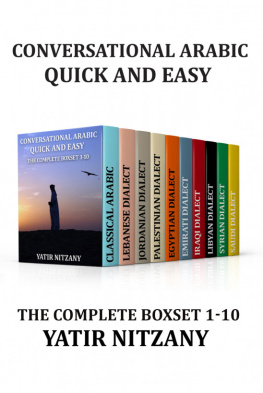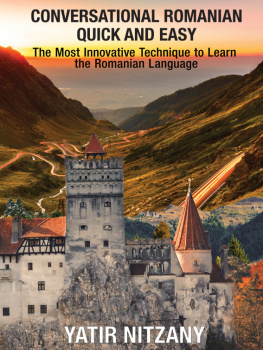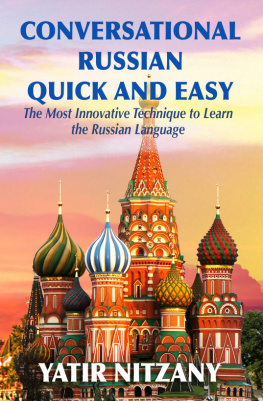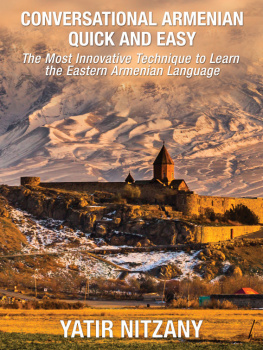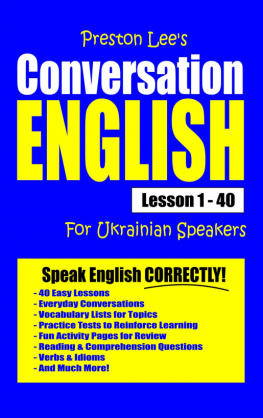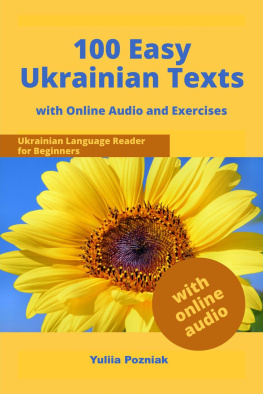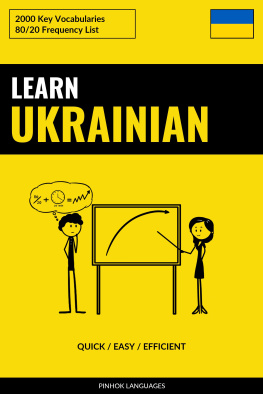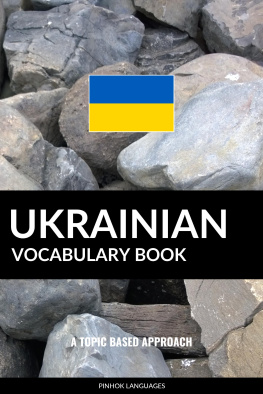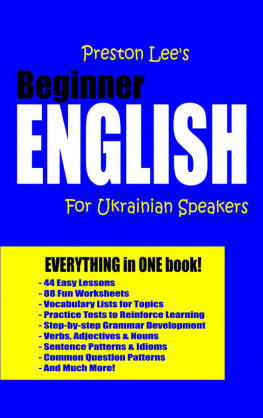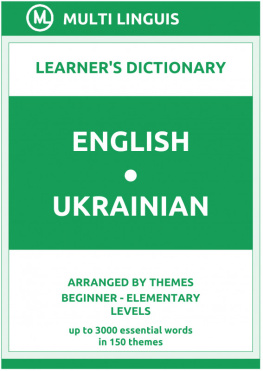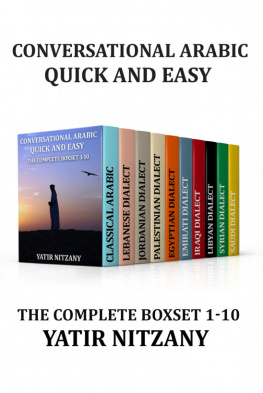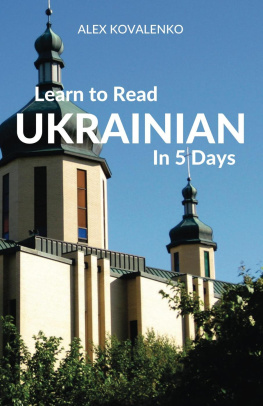Yatir Nitzany
CONVERSATIONAL UKRAINIAN
QUICK AND EASY
The Most Innovative Technique
To Learn the Ukrainian Language
To all those who ever struggled with learning a foreign language and to Wolfgang Karfunkel
About Myself
For many years I struggled to learn Spanish, and I still knew no more than about twenty words. Consequently, I was extremely frustrated. One day I stumbled upon this method as I was playing around with word combinations. Suddenly, I came to the realization that every language has a certain core group of words that are most commonly used and, simply by learning them, one could gain the ability to engage in quick and easy conversational Spanish.
I discovered which words those were, and I narrowed them down to three hundred and fifty that, once memorized, one could connect and create ones own sentences. The variations were and are infinite! By using this incredibly simple technique, I could converse at a proficient level and speak Spanish. Within a week, I astonished my Spanish-speaking friends with my newfound ability. The next semester I registered at my university for a Spanish language course, and I applied the same principles I had learned in that class (grammar, additional vocabulary, future and past tense, etc.) to those three hundred and fifty words I already had memorized, and immediately I felt as if I had grown wings and learned how to fly.
At the end of the semester, we took a class trip to San Jos, Costa Rica. I was like a fish in water, while the rest of my classmates were floundering and still struggling to converse. Throughout the following months, I again applied the same principle to other languagesFrench, Portuguese, Italian, and Arabic, all of which I now speak proficiently, thanks to this very simple technique.
This method is by far the fastest way to master quick and easy conversational language skills. There is no other technique that compares to my concept. It is effective, it worked for me, and it will work for you. Be consistent with my program, and you too will succeed the way I and many, many others have.
GET YOUR FREE eBOOK TODAY!!!

Sign up for the authors New Releases mailing list and get a FREE copy of the latest book Conversational Language Quick and Easy: The Most Innovative Technique to Master the Worlds 27 Most Common Languages.
Click here to get started www.conversational-languages.com/free-ebook/
Introduction to the Program
People often dream about learning a foreign language, but usually they never do it. Some feel that they just wont be able to do it while others believe that they dont have the time. Whatever your reason is, its time to set that aside. With my new method, you will have enough time, and you will not fail. You will actually learn how to speak the fundamentals of the languagefluently in as little as a few days. Of course, you wont speak perfect Ukrainian at first, but you will certainly gain significant proficiency. For example, if you travel to Ukraine, you will almost effortlessly be able engage in basic conversational communication with the locals in the present tense and you will no longer be intimidated by culture shock. Its time to relax. Learning a language is a valuable skill that connects people of multiple cultures around the worldand you now have the tools to join them.
How does my method work? I have taken twenty-seven of the most commonly used languages in the world and distilled from them the three hundred and fifty most frequently used words in any language. This process took three years of observation and research, and during that time, I determined which words I felt were most important for this method of basic conversational communication. In that time, I chose these words in such a way that they were structurally interrelated and that, when combined, form sentences. Thus, once you succeed in memorizing these words, you will be able to combine these words and form your own sentences. The words are spread over twenty pages. In fact, there are just nine basic words that will effectively build bridges, enabling you to speak in an understandable manner (please see in order to gain proficiency in the reading and pronunciation of the Ukrainian language prior to starting this program.
My book is mainly intended for basic present tense vocal communication, meaning anyone can easily use it to get by linguistically while visiting a foreign country without learning the entire language. With practice, you will be 100 percent understandable to native speakers, which is your aim. One disclaimer: this is not a grammar book, though it does address minute and essential grammar rules (please see footnotes at the bottom of every page). Therefore, understanding complex sentences with obscure words in Ukrainian is beyond the scope of this book.
People who have tried this method have been successful, and by the time you finish this book, you will understand and be understood in basic conversational Ukrainian. This is the best basis to learn not only the Ukrainian language but any language. This is an entirely revolutionary, no-fail concept, and your ability to combine the pieces of the language puzzle together will come with great ease, especially if you use this program prior to beginning a Ukrainian language class.
This is the best program that was ever designed to teach the reader how to become conversational. Other conversational programs will only teach you phrases. But this is the only program that will teach you how to create your own sentences for the purpose of becoming conversational.
The East Slavic language of Ukrainian has been the subject of a ban and derision by the Russians and often denied the status of a language in its own right. A quote attributed to Czar Nicholas II goes, There is no Ukrainian language, just illiterate peasants speaking Little Russian, even though the Ukrainian and Russian lexicons differ by 38% (as opposed to 33% for Spanish and Italian). Outside of Russia, Ukrainian and Russian are accepted as two similar but different languages.
Ukrainian is the official state language of Ukraine and the Crimea, the first of two principal languages for Ukrainians, and one of three official languages for the unrecognized state of Transnistria, of which the other two are Romanian and Russian. It is also a recognized minority language in Bosnia and Herzegovina, Croatia, Czech Republic, Hungary, Moldova, Poland, Romania, Serbia, and Slovakia.
Written Ukrainian uses a variant of the Cyrillic script and there are an estimated forty-five million speakers of the language.
Historical linguists trace the origin of the Ukrainian language to the Old East Slavic, from which it split off about a thousand years ago, of the early medieval state of Kievan Rus. After the fall of the Kievan Rus as well as the Kingdom of GaliciaVolhynia, the language developed into a form called the Ruthenian language. The Modern Ukrainian language has been in common use since the late seventeenth century and has been associated with the establishment of the Cossack Hetmanate.
From 1804 until the Russian Revolution, the Ukrainian language was banned from schools in the Russian Empire, of which the biggest part of Ukraine (Central, Eastern, and Southern) was a part at the time. It has always maintained a sufficient base in Western Ukraine, where the language was never banned, in its folklore songs, itinerant musicians, and prominent authors.
The Ukrainian language can be mutually understood, to a degree, by those speaking Belarusian and Russian.


